- (2009) Volume 10, Issue 5
Muhammad Wasif Saif
Medical Oncology, Yale Cancer Center. New Haven, CT, USA
Received: 23 September 2009 Accepted: 11 February 2009
Bone and Bones; Diphosphonates; Jaw; Mandibular Diseases; Maxilla; Osteonecrosis; pamidronate; Surgery, Oral; zoledronic acid
BRONJ: bisphosphonate-related osteonecrosis of the jaw
Dear Sir:
Erkan M, et al. commented on our publication of the first case of a patient with advanced pancreatic cancer and bone metastases who developed bisphosphonaterelated osteonecrosis of the jaw (BRONJ) [1, 2]. Erkan M, et al. also present a potential role of hyperbaric oxygen therapy in these patients [1].
According to a package insert in a special mailing by Merck Pharmaceuticals (Merck & Co., Inc., Whitehouse Station, NJ, USA), the estimated incidence of BRONJ is 0.7 per 100,000 persons per year [3, 4]. Several recent studies of patients with multiple myeloma and patients with breast cancer who received intravenous aminobisphosphonate therapy for metastatic bone lesions demonstrated 6-11% of the patients developed BRONJ. The incidence of BRONJ has been strongly correlated with the aminobisphosphonate pamidronate (Aredia®, Novartis, East Hanover, NJ, USA) and zoledronic acid (Zometa®, Novartis, East Hanover, NJ, USA) and is even higher in patients who have had recent dental extractions [5, 6].
Bisphosphonates are believed to bind to osteoclasts and interfere with bone remodeling. They interfere with the cholesterol biosynthesis pathway by inhibition of farnesyl diphosphate synthase. In time, the cytoskeleton of the osteoclast becomes dysfunctional and the ruffled border needed for bone resorption is unable to form. Aminobisphosphonates have also been shown to have antiangiogenic properties. The overall effect is a decrease in bone turnover and inhibition of the bone’s reparative ability [7, 8]. Injury to the bone in these patients via tooth extraction, dental surgery, or mechanical trauma is thought to initiate BRONJ.
The American Association of Oral and Maxillofacial Surgeons (AAOMS) has proposed a staging system (Table 1) [1]. In addition to discontinuation of bisphosphonate therapy, medical management of BRONJ consists of antimicrobial rinses, systemic antibiotics, and systemic or topical antifungals. It is important to avoid dental therapy or perform minimally invasive dental therapy (i.e., root canal therapy instead of extraction). Surgical intervention for BRONJ remains limited because of the impaired ability of the bone to heal.

The treatment of BRONJ based on the consensus of a panel discussion from AAOMS, is described in Table 2. The role of adjunctive procedures (i.e., hyperbaric oxygen) and vascularized tissue transfers in the reconstructive management of BRONJ have yet to be elucidated. Hyperbaric oxygen therapy is a way of treatment which increases the oxygen content of the blood and, consequently, the amount of oxygen delivered to tissues. Hyperbaric oxygen therapy has been used in the treatment and prevention of osteoradionecrosis of the jaw for more than 30 years [9]. There is some data suggesting the role of hyperbaric oxygen therapy in the management of BRONJ [9, 10, 11, 12]. There are two ongoing randomized controlled trials which are testing the effectiveness of adjunctive hyperbaric oxygen therapy in the management of BRONJ [13] and final results are pending.

One controversy lies about the fear that hyperbaric oxygen may have a cancer-promoting effect or may lead to metastatic growth. Feldmeierr et al. reviewed all available literature and showed that there is no evidence to support this concern [14].
We agree with Erkan M, et al. [1] that a multidisciplinary approach is fundamental for achieving a favorable outcome in patients with BRONJ. The wide use of oral BRONJ have yet to be completely determined. Long-term studies identifying the patients who are at risk for this disease process are still pending.
Conflict of interest The author has no potential conflicts of interest